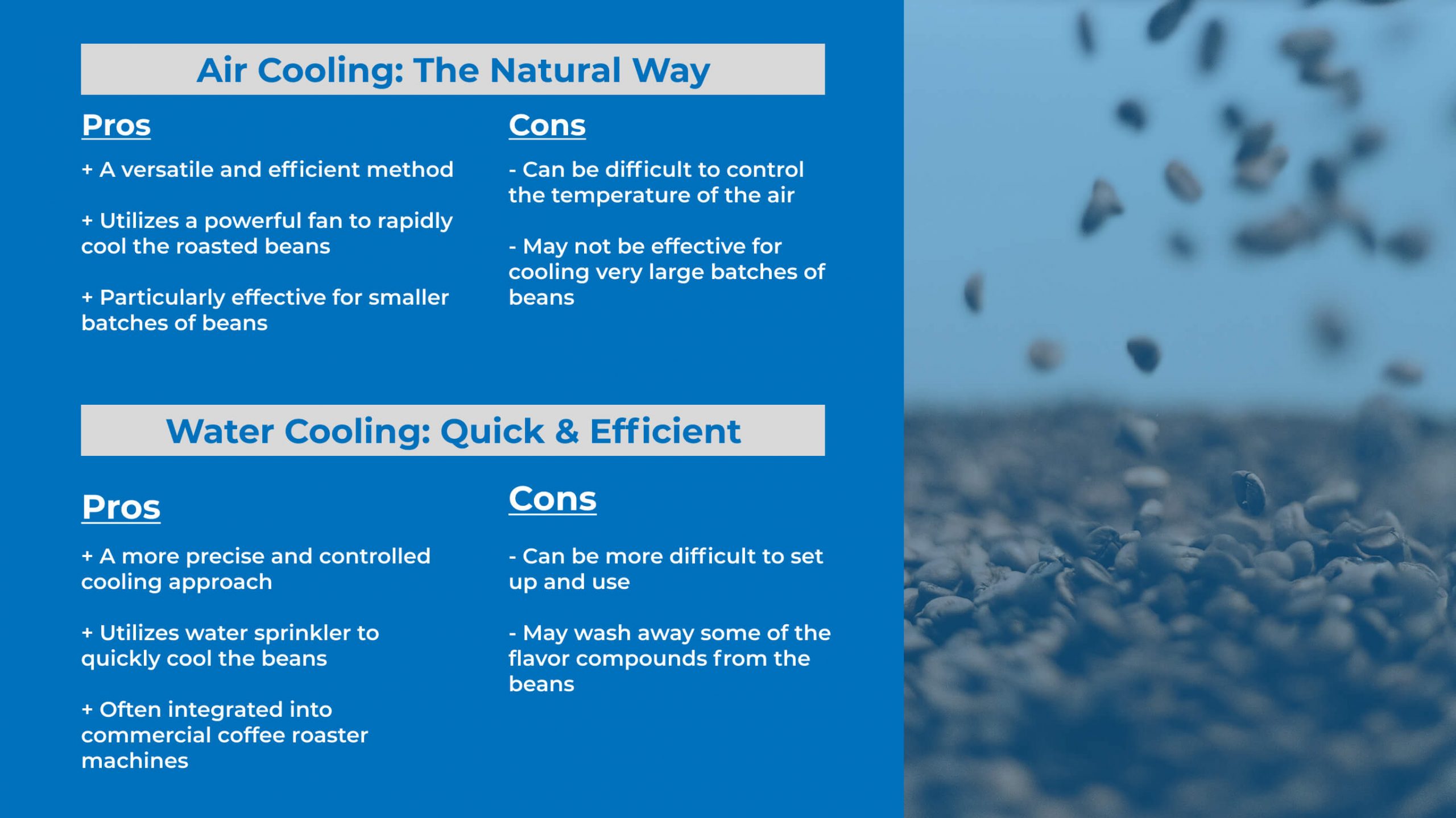Cooling Method: An Essential Step in Coffee Roasting
In the meticulous art of coffee roasting, cooling is not just a final step; it’s a critical process that defines the quality and flavor of the coffee. After the beans reach their desired roast level, uniform cooling needs to be done immediately to halt the roasting process, preserving the intricate flavors and aromas developed during roasting. Without proper cooling, beans are at risk of over-roasting, which can lead to a bitter and unbalanced taste profile.
Cooling down those beans comes down to two main methods: air cooling and water cooling. Each has its own pros and cons, so choosing the right approach is key to getting that perfect roast.
Air Cooling
Air cooling is the traditional and most widely used method in the coffee industry. This technique involves exposing the hot beans to a flow of air, often using a fan, which gradually brings down their temperature to room level. It’s a method favored for its simplicity and effectiveness, especially for smaller batches.
Advantages of The Air Cooling Method:
- Simplicity: Air cooling systems are straightforward to set up and operate.
- Efficiency: This method is highly efficient for cooling smaller quantities of beans uniformly.
- Speed: Air cooling can rapidly bring down the temperature of the beans, reducing the risk of over-roasting.
Disadvantages of The Air Cooling Method:
- Temperature Control: It can be challenging to precisely control the air temperature, which may lead to inconsistencies in cooling.
- Less Effective for LargerBatches: For large batches of beans, air cooling might not be as efficient or uniform.
Water Cooling
Water cooling, although less common than air cooling, offers greater precision. In this method, a fine mist of water is sprayed onto the beans. The water rapidly absorbs heat from the beans, cooling them quickly and uniformly. This method is particularly useful for industrial batches or when a specific bean temperature is targeted post-roast.
Advantages of The Water Cooling Method:
- Precision: Water cooling allows for more precise temperature control during the cooling process.
- Specific Temperature Targeting: Ideal for achieving exact cooling temperatures, which can be crucial for specific roasting profiles.
- Efficiency for LargerBatches: Highly effective for industrial scale batches where uniform cooling is crucial.
Disadvantages of The Water Cooling Method:
- Complexity: Setting up a water cooling system can be more complex than air cooling.
- Flavor Risk: There’s a potential risk of washing away some flavor compounds, affecting the coffee’s taste.

Extra Tip: Resting Period
After cooling, coffee beans should undergo a resting period. This allows the beans to stabilize and develop a more rounded and cohesive flavor profile.
Here is what you can do to optimize the cooling and resting process:
- Rapid Cooling: Aim to cool the beans as swiftly as possible post-roast to arrest the cooking process effectively.
- Room Temperature Goal: Cool the beans down to ambient room temperature for optimal storage and further processing.
- Uniform Cooling: Ensure the beans are cooled evenly to prevent uneven flavor development.
- Temperature Monitoring: Use a thermometer to monitor bean temperature during cooling accurately.
- Resting Time: Allow the beans to rest for an adequate period, usually a few hours to several days, depending on the roast level and intended use.
Why do we need to cool the beans?
- Halts the Roasting Process: Coffee beans continue to roast due to internal heat even after being removed from the heat source. If they aren’t cooled promptly, they can over-roast, leading to a burnt taste and loss of nuanced flavors. Proper cooling stops this process, ensuring the beans retain the desired roast level and flavor profile.
- Preserves Flavor and Aroma: The roasting process is all about developing complex flavors and aromas in the coffee beans. Cooling locks in these characteristics at their peak. If beans aren’t cooled correctly, you risk losing these delicate and desirable attributes, resulting in a less flavorful cup of coffee.
How does the cooling method we choose affect the beans?
Choosing the right cooling method is equally important for several reasons.
- Impact on Flavor and Quality: Different cooling methods can affect the beans differently. For example, water cooling might lead to a slight loss of oils and flavor compounds, while air cooling is more neutral but may not be as efficient for larger batches.
- Consistency and Control: The right method provides better control over the cooling process, ensuring consistency in roast quality across batches. Consistency is key in coffee roasting, as even slight variations can lead to significantly different tastes.
- Efficiency and Practicality: Depending on the scale of roasting (commercial vs. home roasting), the efficiency of the cooling method can be crucial. For large-scale operations, a quicker method might be necessary, whereas, for small batches, a more straightforward method might suffice.
Whether you’re a home enthusiast or a professional roaster, paying attention to how you cool your beans can make all the difference in achieving that perfect cup of coffee.
Designed with an integrated fan for effective air cooling, and an average cooling time of just 4 minutes, Berto’s machines streamline your roasting process without compromising on quality. Ideal for busy coffee businesses, our coffee roaster machines help maintain the perfect balance of flavor and aroma in every batch, ensuring your coffee stands out for its taste and consistency.
For more insights into the world of coffee, from roasting techniques to brewing tips, make sure to follow us on Instagram and like us on Facebook. Or chat with our team about your needs if you’re seeking a roasting machine to kickstart your coffee adventures!

